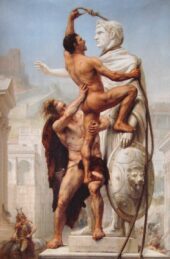Battle for the Island Kingdom
Mention “1066” to any history buff and you will immediately bring to mind the “Year of Three Battles,” in which Vikings, Normans and Anglo-Saxons fought it out for mastery of England. The struggle ended, violently, with the climactic Battle of Hastings in October of that year. Possibly no other battle had so great an effect on English – and so, European and American – history, right down to the very language we speak today. Hastings, however, was just the culmination of a generations-long fight for supremacy: bloody wars, intrigues and sexual politics, in which only one man could finally rule supreme.
My new book from Osprey Publishing, Battle for the Island Kingdom, documents the six and a half decades leading up to the year 1066, beginning with the dawn of the 2nd Millennium. Then, the Normans – i.e., descendants of Norsemen interbred with the native French – were still a people of little note on the south Channel coast. The contest was primarily between the Anglo-Saxons, who had conquered England after the Romans abandoned it, and a new breed of raiders, the Danes. For almost 90 years these two had divided the island between them, until the descendants of Alfred the Great finally ran the Vikings back across the North Sea. Not all of Alfred’s progeny, however, were as inspiring, martially adept, or successful as he. By the new millennium the Vikings were pillaging England again and selling their loot across the English Channel in Normandy. Anglo-Saxon king Aethelred II, called Unraed, – meaning “Ill-Advised” but usually translated as “Unready” – was unable to defeat the Vikings in battle, and so sought to resolve the conflict in other ways. He married teenaged Emma, daughter of the Duke of Normandy (thereby allying the Normans with him against the Vikings), and ordered the St. Brice’s Day Massacre, a genocidal slaughter of any and all Danes remaining on English shores. All this was just the first of a bloody tangle of intrigues, betrayals, and murders between the myriad dynamic personalities that would come to dominate the ensuing decades.
Feckless Aethelred did not last long. Both England and Queen Emma were conquered by the Viking Cnut the Great, who made the Island Kingdom part of his North Sea Empire and Emma his queen. Cnut’s Saxon consort Aelfgifu had already borne him two sons, but was usurped when Emma claimed Cnut’s realm in exchange for her body. Their sons, kings Harefoot and Harthacnut, would become weapons in their mothers’ wars. Yet it was Emma’s son by Aethelred, the half-Norman/half-English Edward, who ultimately rose to sit on the English throne. That led to a whole new set of backstabbing, double-crosses and banishments.
As king Edward, who would become known as the Confessor, was a tool of his quarrelling lords. His very bed became a battleground when he was compelled to marry the daughter of Godwin, Earl of Wessex. Godwin had played all sides to make himself the most powerful man in England, including the gruesome murder of Edward’s young brother at Harefoot’s behest. In the 1050s king and earl, in their efforts to dominate each other, almost plunged the kingdom into civil war. Childless Edward managed to banish Godwin and his sons, and was even said to have promised his kingdom to the Norman side of his family. Yet Godwin returned even stronger, forcing the king to submit. On his death the earl passed his power to his son Harold, who would sacrifice his family and risk the realm to retain it, for his brother Tostig, exiled and bitter, was willing to sell his soul to the Vikings for a crown. And that brought Norwegian king Harald Hardrada, the infamous “Hard Ruler,” into the picture, to mount one last attempt to make England Viking again.
And all this time young Duke William of Normandy, fatherless, having barely survived his own barons’ rebellions and assassination attempts and, against all odds, grown to manhood, was crushing all resistance in his anarchic dukedom. Hardened by experience, wily and merciless, he turned covetous eyes on England….
So in the end William the Conqueror was practically a last-minute walk-on in the story of 11th century England. Those history buffs who recall 1066 might think everything of importance took place that year, but actually the “Year of Three Battles” is only the end of the story. Battle for the Island Kingdom tells it from the beginning, in a sweeping saga that fans of Game of Thrones, The Last Kingdom, and Vikings: Valhalla will enjoy.
Don Hollway is the author of Battle for the Island Kingdom: England’s Destiny 1000-1066 now available from Osprey Publishing.







